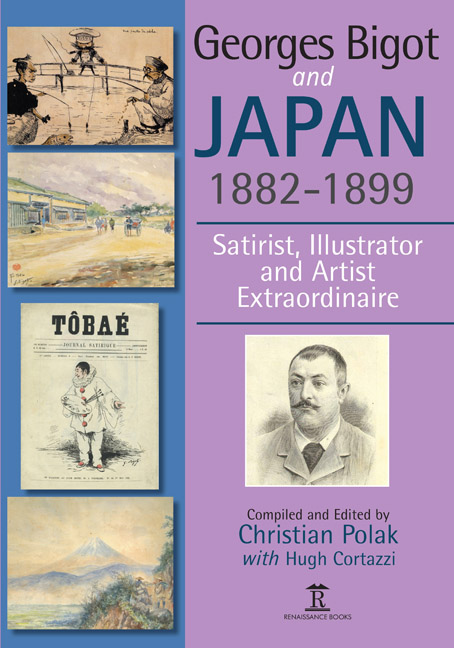Georges Bigot’s ‘Modern Japan
Published online by Cambridge University Press: 30 April 2022
Summary
After his discovery of traditional Japan and following his decision in 1886 to continue to live in the Japan of his dreams, Bigot sharpened his focus and became a critic of the society developing into the so-called ‘new Japan’. While still making time for painting, Bigot henceforth concentrated on satirizing ‘modern’ Japan. He became a talented caricaturist in the wake of Charles Wirgman, but with a different approach. This is apparent from a careful look at the cover pages of Japan Punch (April 1880 edition) and of Tôbaé (1 May 1887 edition), which carried self-portraits of the two artists. Wirgman depicts himself as a samurai in hakama, the ceremonial costume of the Japanese warrior, but with the pen replacing the sword and with two cranes and a cat by his side, while Bigot disguised himself as Pierrot in a theatrical pose carrying his palette of paints in his right hand.
Wirgman added long written explanations under his caricatures, while Bigot put his main emphasis on his drawings with very short captions. Thus, Wirgman was portrayed as a writer and Bigot as a painter. The two caricaturists knew one another for a brief period (see separate article about Wirgman in this volume). In the last numbers of Japan Punch Wirgman welcomed Tôbaé with some admiring comments and seemed proud to have a worthy successor in the social landscape of Meiji Japan.
Influenced by Nakae Chōmin, Bigot became involved with the liberal movement Jiyū Minken undō (campaign for liberty and people's rights) which was also supported by the French jurist Boissonade. In 1884, Bigot had tried to launch a satirical journal Tobaye but it did not survive beyond its initial issue. Finally, on 15 February 1887, he launched his periodical Tôbaé, which lasted three years and had sixty-nine numbers. It was followed by La Vie Japonaise (Japanese Life) in 1890 and then by Potins de Yoko, also in 1890, and finally by Le Potin in 1893. This appeared for seven years until 1899. Bigot, therefore, produced four periodicals over a span of ten years. These were accompanied by numerous humorous albums on specific topics (see list in the Bibliography).
Bigot utilized copperplate engraving and lithography in creating his caricatures. He drew a distinction between the old and the new, the traditional and the modern.
- Type
- Chapter
- Information
- Georges Bigot and Japan 1882-1889Satirist, Illustrator and Artist Extraordinaire, pp. 117 - 194Publisher: Amsterdam University PressPrint publication year: 2018

